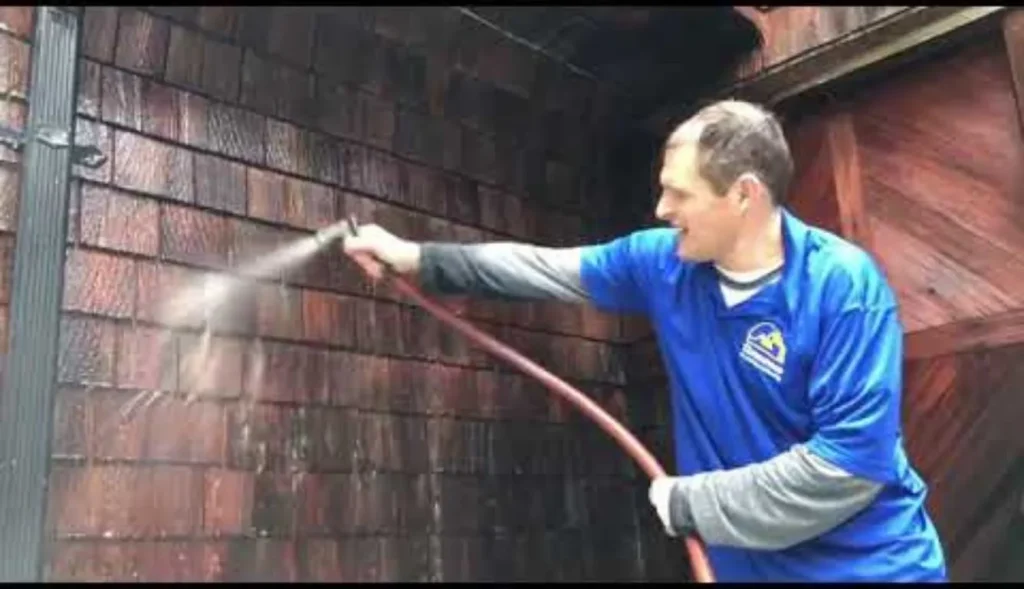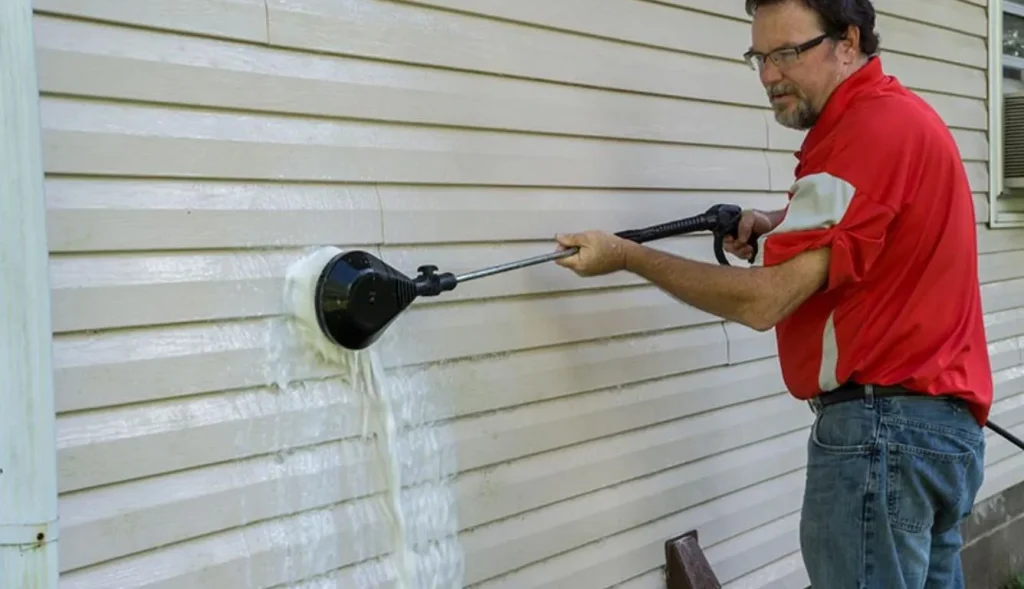Introduction
Cedar siding is cherished for its rustic charm and natural appeal, but like any exterior material, it requires regular maintenance to stay in top condition. Over time, dirt, mold, mildew, and other contaminants can accumulate on the surface, dulling its appearance and potentially causing damage. Understanding how to properly clean cedar siding is key to preserving its beauty and ensuring it remains a protective barrier for your home.
In this guide, we’ll explore everything from the basics of cedar siding to detailed, step-by-step instructions on how to clean it effectively. Whether you’re using a pressure washer or opting for a gentler approach, we’ve got you covered.

Understanding Cedar Siding
What Makes Cedar Siding Special?
Cedar siding is known for its durability, natural resistance to decay, and ability to insulate against both heat and cold. The wood’s natural oils help repel insects, making it a popular choice for homeowners who want a low-maintenance yet aesthetically pleasing exterior. However, cedar is still a natural material, which means it’s susceptible to weathering, dirt buildup, and biological growth like mold and mildew.
Common Issues with Cedar Siding
Despite its advantages, cedar siding can develop problems if not properly maintained. Common issues include:
- Fading: Prolonged exposure to sunlight can cause cedar siding to fade and lose its rich color.
- Mold and Mildew: Moist environments can lead to the growth of mold and mildew, which not only looks unsightly but can also cause health problems.
- Cracking and Splitting: Over time, cedar siding can crack or split, especially if it’s not regularly cleaned and sealed.
Preparing for the Cleaning Process
Gather the Necessary Tools and Materials
Before you begin cleaning, it’s essential to gather all the tools and materials you’ll need. This will make the process smoother and more efficient. Here’s a list of what you’ll need:
- Soft-bristle brush or sponge
- Garden hose with a spray nozzle
- Bucket
- Ladder (if necessary)
- Cleaning solution (homemade or commercial)
- Protective gear (gloves, safety goggles, mask)
- Tarp or plastic sheeting (to protect nearby plants and surfaces)
Inspect the Siding for Damage
Before you start cleaning, take a close look at your cedar siding. Check for any signs of damage, such as cracks, splits, or areas where the wood is rotting. If you find any significant damage, it might be best to repair these areas before proceeding with cleaning, as water and cleaning solutions could exacerbate the problem.
Protect Surrounding Areas
Cedar siding cleaning can involve the use of water and cleaning agents that may harm plants, windows, or other surfaces around your home. Use tarps or plastic sheeting to cover plants, windows, and other areas you want to protect from overspray or runoff.
Choosing the Right Cleaning Solution
Homemade Cleaning Solutions
For those who prefer a natural approach, homemade cleaning solutions can be effective and safe for cedar siding. A simple mixture of water, white vinegar, and a bit of dish soap can do wonders in removing dirt and grime. Here’s a basic recipe:
- 1 gallon of warm water
- 1 cup of white vinegar
- 1 tablespoon of mild dish soap
This solution is gentle on cedar but tough on dirt.
Commercial Cleaning Products
If you’re dealing with more stubborn stains or mold, a commercial cleaner specifically designed for wood or siding might be necessary. These products are formulated to break down tougher grime without damaging the wood. Always follow the manufacturer’s instructions and test the product on a small area first.
When to Use a Mildew or Mold Cleaner
If you notice black spots or a musty smell, you might be dealing with mildew or mold. In this case, a specialized cleaner that targets mold and mildew is essential. Look for products that are safe for cedar siding and follow the application instructions carefully.
Step-by-Step Guide to Cleaning Cedar Siding
How to Safely Clean Cedar Siding
Now that you’re prepared, it’s time to get down to the actual cleaning. Follow these steps to ensure a thorough and safe cleaning process:
Rinsing the Siding
Start by rinsing your cedar siding with a garden hose. This initial rinse will remove loose dirt and debris, making it easier to apply the cleaning solution. Use a spray nozzle with a gentle setting to avoid damaging the wood.
Applying the Cleaning Solution
Next, apply your chosen cleaning solution to the siding. If you’re using a homemade solution, you can apply it with a soft-bristle brush or sponge. For commercial products, follow the instructions on how to apply—some may require you to spray the solution on, while others might suggest brushing it in.
Scrubbing and Rinsing Again
Once the cleaning solution is applied, use a soft-bristle brush to gently scrub the siding, focusing on areas with more buildup. Avoid scrubbing too hard, as this could damage the wood. After scrubbing, thoroughly rinse the siding with water to remove any remaining soap or cleaner.
Dealing with Stubborn Stains
If you encounter stains that don’t come off with regular cleaning, you might need to take a more targeted approach. Consider using a stronger cleaning solution or repeating the process in particularly dirty areas. For persistent mold or mildew, a mildew-specific cleaner and some elbow grease should do the trick.
Cleaning Cedar Siding Without a Pressure Washer
The Advantages of Avoiding Pressure Washing
Pressure washing might seem like a quick and effective way to clean cedar siding, but it comes with risks. The high pressure can force water deep into the wood, potentially leading to damage over time. Additionally, if not done correctly, pressure washing can strip away the wood’s natural oils and protective finish.
Alternative Methods for Cleaning
If you prefer to avoid pressure washing, you can still achieve a thorough clean with a garden hose, a soft brush, and a little patience. This method is gentler on the wood and reduces the risk of damage.
Using a Pressure Washer on Cedar Siding
When Is It Appropriate?
There are times when pressure washing might be necessary, particularly if you’re dealing with a large area of heavily soiled siding. If you choose to use a pressure washer, make sure to use the lowest pressure setting and keep the nozzle at least 18 inches away from the surface.
Proper Pressure Washing Techniques
When pressure washing, move the nozzle in a consistent, sweeping motion, avoiding staying in one spot for too long. This helps prevent the water from penetrating too deeply into the wood. Always work from top to bottom to ensure that dirt and debris are washed away from the surface.
Potential Risks and How to Avoid Them
The main risk of pressure washing cedar siding is water damage. To minimize this risk, avoid using too much pressure, keep a safe distance, and ensure that the wood has time to dry completely after cleaning. Also, consider reapplying a finish or sealant after pressure washing to protect the wood.
Post-Cleaning Care
Inspect for Any New Damage
After cleaning, take the time to inspect your cedar siding for any new damage that may have occurred during the process. Look for signs of water damage, such as swelling or discoloration, and address any issues promptly.
Reapplying Finishes or Stains
Cleaning cedar siding can sometimes remove part of the finish or stain. If you notice this, it might be time to reapply a protective finish. This will help protect the wood from future dirt buildup and UV damage. Choose a stain or finish that is specifically designed for cedar siding for the best results.
How Often Should Cedar Siding Be Cleaned?
Regular cleaning is key to maintaining cedar siding’s beauty and longevity. Generally, cleaning your siding once a year is sufficient, but you may need to do it more often if your home is in a particularly humid or dirty environment.
Common Mistakes to Avoid
Using Harsh Chemicals
Harsh chemicals can damage cedar siding by stripping away its natural oils and causing the wood to dry out and crack. Always opt for gentle, wood-safe cleaners and avoid bleach or other abrasive substances.
Ignoring Safety Precautions
Cleaning cedar siding involves working with cleaning solutions, water, and possibly a ladder. Always wear protective gear, like gloves and safety goggles, and make sure your ladder is stable before climbing.
Neglecting Regular Maintenance
Skipping regular maintenance can lead to bigger problems down the road. Dirty or damaged siding not only looks bad but can also lead to more severe issues like rot or insect infestations. Make cedar siding maintenance a regular part of your home care routine.
FAQs
How often should I clean my cedar siding?
It’s recommended to clean your cedar siding at least once a year to keep it looking its best and to prevent dirt, mold, and mildew buildup.
Can I use bleach to clean cedar siding?
Bleach is not recommended for cedar siding as it can be too harsh and may damage the wood. Instead, opt for gentler, wood-safe cleaners.
What should I do if I notice mold or mildew?
If you notice mold or mildew, use a cleaner specifically designed to target these issues. Be sure to follow the product instructions carefully to avoid damaging the wood.
Is it safe to pressure wash cedar siding?
While it can be safe to pressure wash cedar siding if done correctly, it’s essential to use a low-pressure setting and maintain a safe distance from the surface to avoid causing damage.
How can I prevent cedar siding from becoming dirty?
Regular maintenance, such as cleaning and reapplying protective finishes, will help prevent your cedar siding from becoming dirty. Additionally, keeping gutters clean and trimming back vegetation can reduce the buildup of dirt and debris.

Conclusion
Cleaning cedar siding might seem like a daunting task, but with the right approach, it can be manageable and even satisfying. Regular cleaning and maintenance will keep your siding looking great and protect your home from potential damage. By following the steps outlined in this guide, you can ensure that your cedar siding remains a beautiful and durable feature of your home for many years to come.


Congratulation!